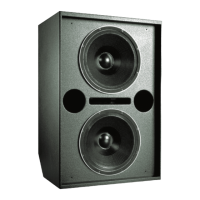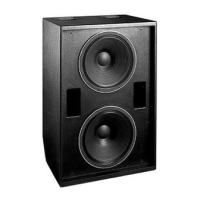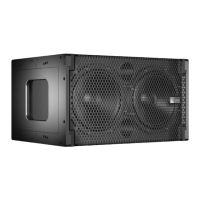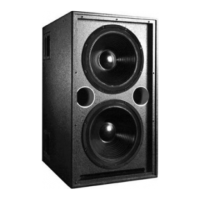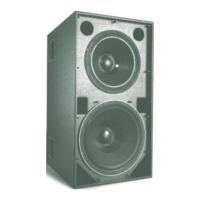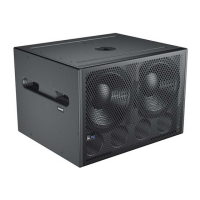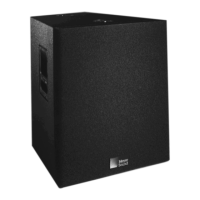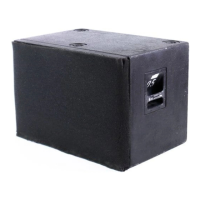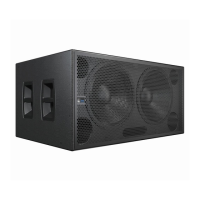Do you have a question about the Meyer Sound 600-HP and is the answer not in the manual?
Details the dual 15-inch cone drivers and amplifier output.
Describes available side-panel options and rigging compatibility.
Explains the Intelligent AC power supply's automatic voltage selection and protective functions.
Outlines safe operating voltage ranges and conditions for the 600-HP.
Discusses proper grounding and connection practices for AC power distribution.
Details current ratings and considerations for selecting appropriate circuit breakers and cables.
Describes the 600-HP's balanced XLR input impedance and wiring conventions.
Covers driver configuration, amplifier details, and cabling options.
Explains the advanced TruPower limiting and its effect on performance and driver life.
Details the forced-air cooling system, including fans and thermal protection.
Describes the LEDs and buttons on the RMS communication module's user panel.
Outlines the graphical Windows interface for monitoring system parameters.
Discusses factors influencing subwoofer response based on placement.
Details how to rig and integrate the 600-HP with MICA arrays.
Explains basic connection options with other Meyer Sound loudspeaker series.
Covers integration using LD-1A/LD-2, LD-3, Galileo 616, and DSPs.
Introduces the acoustical prediction software for system design.
Describes the audio analyzer for system measurement and alignment.
Details the QuickFly system and GuideALink frame for suspension.
Covers various combinations for linking 600-HPs and MICA for flown/stacked arrays.
Describes the MG-MICA grid and MDTL-MICA downtilt link for arrays.
Details the MCF-MICA caster frame and MDB-600 dolly board for transport.
Instructions for installing the weather-protection rain hood.
Step-by-step guide for servicing the amplifier module.
Details frequency response, SPL, coverage, and operating ranges.
Provides information on the 15-inch cone drivers, impedance, and power handling.
Outlines input type, impedance, wiring, and sensitivity details.
Lists amplifier type, output power, THD, load capacity, and cooling.
Covers connector types, voltage ranges, current draw, and safety ratings.
Includes enclosure details, dimensions, weight, and rigging compatibility.
Details RMS network capabilities and connectivity.
Details the dual 15-inch cone drivers and amplifier output.
Describes available side-panel options and rigging compatibility.
Explains the Intelligent AC power supply's automatic voltage selection and protective functions.
Outlines safe operating voltage ranges and conditions for the 600-HP.
Discusses proper grounding and connection practices for AC power distribution.
Details current ratings and considerations for selecting appropriate circuit breakers and cables.
Describes the 600-HP's balanced XLR input impedance and wiring conventions.
Covers driver configuration, amplifier details, and cabling options.
Explains the advanced TruPower limiting and its effect on performance and driver life.
Details the forced-air cooling system, including fans and thermal protection.
Describes the LEDs and buttons on the RMS communication module's user panel.
Outlines the graphical Windows interface for monitoring system parameters.
Discusses factors influencing subwoofer response based on placement.
Details how to rig and integrate the 600-HP with MICA arrays.
Explains basic connection options with other Meyer Sound loudspeaker series.
Covers integration using LD-1A/LD-2, LD-3, Galileo 616, and DSPs.
Introduces the acoustical prediction software for system design.
Describes the audio analyzer for system measurement and alignment.
Details the QuickFly system and GuideALink frame for suspension.
Covers various combinations for linking 600-HPs and MICA for flown/stacked arrays.
Describes the MG-MICA grid and MDTL-MICA downtilt link for arrays.
Details the MCF-MICA caster frame and MDB-600 dolly board for transport.
Instructions for installing the weather-protection rain hood.
Step-by-step guide for servicing the amplifier module.
Details frequency response, SPL, coverage, and operating ranges.
Provides information on the 15-inch cone drivers, impedance, and power handling.
Outlines input type, impedance, wiring, and sensitivity details.
Lists amplifier type, output power, THD, load capacity, and cooling.
Covers connector types, voltage ranges, current draw, and safety ratings.
Includes enclosure details, dimensions, weight, and rigging compatibility.
Details RMS network capabilities and connectivity.
| Brand | Meyer Sound |
|---|---|
| Model | 600-HP |
| Category | Subwoofer |
| Language | English |
